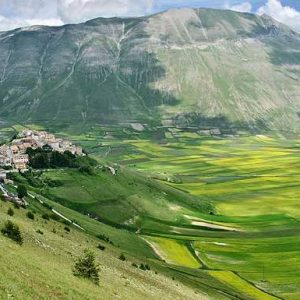
Marche and Umbria
In the territory where the regions of Marche and Umbria are located, they were occupied by the Umbrian and Piceni tribes, long before the Romans dominated the Italian peninsula. As it was custom and until recent times most of the people had two meals a day consisting typically of boiled grain or chickpeas, lentils or other legumes available in the area, and of games, fish, bread and milk products. The wild boars, abundant in this area, trained the hunters to butcher, prepare and master the art to preserve and cure the meat, an ability inherited from the Etruscans. The bread made in these regions, is of the highest quality and made in various flavors and taste according to the ingredients used: each town, each bakery, each family makes a singular shaped and tasting different bread, with a distinct and personal touch.
Marche
The Marche offers as a unique appetizer the Olive all’Ascolana. They are olives stuffed with chopped veal, chicken liver and tomato paste, cooked with lard and flavored with cheese, parsley, nutmeg and than breaded and fried in olive oil. The local ravioli are dumplings stuffed with meat and spinach, and the Brodetto a fish stew prepared in San Benedetto del Tronto, are specialties exclusive of the area. Pigs and free range black pigs are used in the production of ham and sausage specialties: Prociutto di Montefeltro, made from black pigs, many varieties of salami, liver sausage and soppressate. The smoked mortadella is made with pork’s lean and fat meat and lungs, livers, hearts, seasoned with salt and peppercorn; the Coppa is a sausage made from pig’s head with bacon, seasoned with nutmeg, orange zest, pine nuts and almonds and the unusual Ciavuscolo is a salami to spread deliciously in a sandwich or as a canapé. In the countryside, there is a large production of vegetables, legumes and grapes which are basic part of their diet. The Piceno red and white wines, their famous olive oil and the pecorino cheese made with sheep milk are proudly produced in the traditional method.
Umbria
Umbria is a small region of 3265 square miles with 850,000 inhabitants. It is a region with great traditions and history, with beautiful scenic views and modern cities vibrant with life. A preferred destination to the tourists for art, music (the Spoleto Jazz Festival), the peaceful surroundings, the friendly people and the uncomplicated and delicious cuisine. Umbria is not touched by the sea. The territory is covered by farms and agriculture is the main economic resource. House gardens provide fresh provisions; the local Chianina cattle and farm raised pigs supply first quality beef, pork and pork products. The Umbrian are temperate people, their taste is simple like their cooking: few condiments, the fresh local olive oil, black truffles, marjoram and fennel which grows abundantly by the many rivers and lakes that also are a source of a variety of freshwater fish. The butcher in Italian is called norcino; Norcino also is an inhabitant of Norcia, an Umbrian town where the art of butchering was thriving. In Norcia and in the area pork products are at the very best, from the pork neck they produce the capocollo seasoned with garlic and peppers and served as an appetizer. Also served as antipasto the Prociutto di Norcia made with pigs fed exclusively with acorns, the crostini, toasts covered with sautéed spleen or chicken liver and tartufi, the black truffles, fillets of anchovies and capers, or the pizza called schiacciate covered with preserved pork meat. The Mazzafegati is a liver sausage that can be “hot” with chili pepper or sweet, as a dessert, with honey, raisins, pine nuts and orange peels.
Some of the main dishes are: the cariole which is noodles with garlic sautéed with fresh olive oil, or the pasta refried with eggs, sausages and cheese, or the risotto with mushrooms. These dishes are served with grated black or white truffles and cheese. Lentil’s soup and minestra di faro, spelt soup are traditional fares. Spits and grill cooking is common in Umbria. The famous Roman Porchetta, a young hog roasted whole is a typical Umbrian specialty. Beef steaks made with Chianina cattle are barbequed as is the coratella, the liver and heart, and the woodcock, stuffed with giblets, sausages and black truffles, is also barbequed. Other meats and game are stewed often with the abundant lentils. The Regina in Porchetta is carp cooked like Porchetta and stuffed with fennels, chopped liver, garlic, salt and pepper. Tasty chowder is made with an assortment of freshwater fish cooked with wild fennels, olive oil and wine. The desserts made in Umbria are unique. Perugia is the home of Perugina products, from chocolate to Panettone, to a variety of cookies and cakes exported all over the world.
The famous Panpepato a fruitcake made in Siena, originally containing pepper which was substituted with vanilla, it was made for Christmas and now it is available all the time. A homemade dessert prepared for Christmas consists of simply boiled noodles mixed with cinnamon and sugar and sprinkled with zest of lemon and toasted chopped walnuts. For Easter, the city of Perugia offers the Ciaramicola a ring-shaped red cake covered with egg white whipped with sugar and made with butter, eggs, flour and alkermes, a liquor made with berries (the kermes which give the characteristic red color), cinnamon, cloves, nutmeg and vanilla. Among the many good wines, the white Orvieto, the red Torgiano Rosso and the Vin Santo, a sweet and prized dessert wine.
